Identity diagrams are diagrams that a person can use to see and organize different parts of their identity in one place, compare their identity to the rest of an identity spectrum, and so on. A general identity diagram will display aspects such as age, job, nationality, race, religion, gender, sexuality, and many more.[1] The following diagrams on this page are examples of identity diagrams that are specific to the LGBTQIA+ community, though there are many more besides the ones listed here.
Examples of Identity Diagrams[]
Kinsey Scale[]
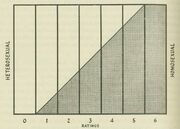
Kinsey Scale developed by Alfred Kinsey and originally published in Sexual Behavior of the Human Male.
The Kinsey Scale, also known as the Heterosexual–Homosexual Rating Scale, was first introduced in Alfred Kinsey's 1948 book Sexual Behavior in the Human Male, but was also prominent in the complementary work Sexual Behavior in the Human Female.[2] It was created as research findings began to demonstrate that sexuality was not binary and people did not fit into exclusive hetero= or homosexual categories.[2] The scale was originally used to rate individuals based on behavior, as opposed to self-identifying labels;[3] Kinsey also acknowledged that sexuality was a continuum (as opposed to being binary)[4] and that the seven categories - ranging from 0 (exclusively heterosexual) to 6 (exclusively homosexual) and the addition of an X to indicate no sociosexual contacts or relations - could not capture the sexuality of every individual.[5]
Klein Grid[]
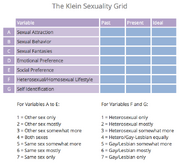
The Klein Grid
Developed in 1978 by Dr. Fritz Klein, the Klein Grid is meant to "better illustrate the complexity and nuance of human sexuality". It is not meant to give a person a definitive answer about their own sexuality, but instead it can help people see parts of their sexuality together.[6]
The Gender Diamond[]
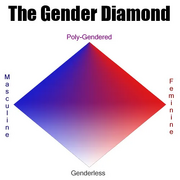
The Gender Diamond graph
A very basic gender identity diagram, showing a diamond with four attributes, one for each point on the diamond: masculine, feminine, poly-gendered, and genderless. One use for this diagram is for multiple people to place a dot on the diamond that represents where their gender is in relation to the attributes at the points. The exact creator of this diagram is unknown, but the earliest known point when this diagram was available online was September 6th, 2011, and before then it was found on Tumblr.[7]
The Genderbread Person[]

The latest revision of the Genderbread Person diagram
The Genderbread Person is a diagram that a person can use to break down parts of their sexuality and gender identities into specific pieces. There are several different versions of this diagram online, but the latest version in particular allows people to map out their gender identity, gender expression, anatomical sex, sexual attraction, and romantic attraction.[8]
The original diagram was first created by Sam Killermann sometime in 2012.[9] The latest revision was made available online in 2017.[10]
The Gender Venn Diagram[]
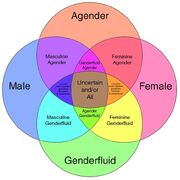
The Gender Venn Diagram
A gender diagram made up of four circles, each representing male, female, agender, and genderfluid. The overlaps between the circles represent various identities, such as masculine agender and feminine genderfluid. The center overlap can represent either being uncertain or identifying as all genders.[11] The exact creator of this diagram is unknown, but its earliest publication was on April 6th, 2015.[12]
The Gender Spectrum[]
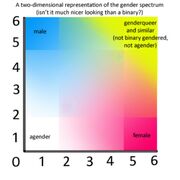
The Gender Spectrum graph
Another basic gender identity diagram, in this case it is a graph that is similar to the Gender Diamond. It was made to represent the gender spectrum beyond just the gender binary. In comparison, this chart replaces "poly-gendered" with genderqueer/non-binary, and "genderless" with agender. The earliest instance of this graph being available online was September 13th, 2015.[13]
The Gender Unicorn[]

The Gender Unicorn diagram
A diagram that was designed by Landyn Pan and Anna Moore, and was first published in 2015. This diagram was based on an older version of the Genderbread Person.[14]
The Gender Unicorn was created mainly to address the lack of acknowledgement of other genders outside of the gender binary, which the Genderbread Person did not cover adequately at the time. It also corrects issues related to the terminology used in the Genderbread Person's older diagrams.[14]
The Gender Cone[]

The Gender Cone diagram
A gender identity diagram that was created by Olivia Paramour and made available online in September 2020. This diagram is unique compared to previous diagrams on this page in that it takes into account the intensity of a person's gender, which thus includes genders such as demigender and graygender. The bottom point of the cone represents agender, while the top circle represents non-agender gender identities, with neutrois in particular being placed in the middle.[15]
The Orientation & Identities Diagram[]
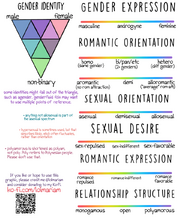
The Orientation & Identities diagram
Sometime in June 2021, this diagram was created by Mariam El-Haj and shared via Ko-Fi. Similar to the Genderbread Person and Gender Unicorn, this diagram allows a person to map out their gender identity, gender expression and orientation. It also includes options for sexual desire, romantic expression, and relationship structure (i.e. if a person is monogamous, polyamorous, or somewhere in between).[16]
The Trevor Project Identity Diagrams[]

An example of one of the identity diagrams featured in the Trevor Project's Coming-Out Handbook
In July of 2021, the Trevor Project designed a free online handbook to help LGBTQIA+ youth with coming out to others about their identity. Part of this handbook includes amorphous identity diagrams made of different blobs of colors. The design was created as such to represent how identities may not be exactly clear cut, and may blend together with one or more identities. The handbook shows diagrams for gender identity, gender expression, sexual attraction, romantic attraction, and emotional attraction.[17]
Resources[]
- Bi.org page on the Kinsey Scale and Klein Grid
- The Genderbread Person main website
- The Gender Unicorn main website
- Download page for the Orientations & Identities diagram by Mariam El-Haj
- The Coming-Out Handbook created by the Trevor Project
- PDF version of the Trevor Project's Coming Out Handbook
References[]
|
